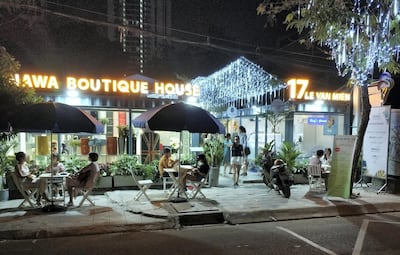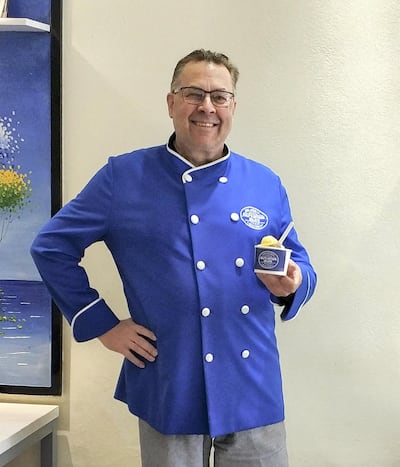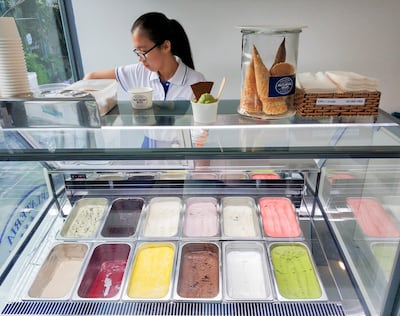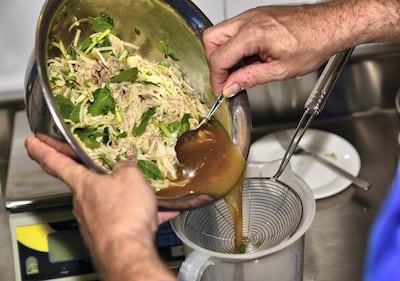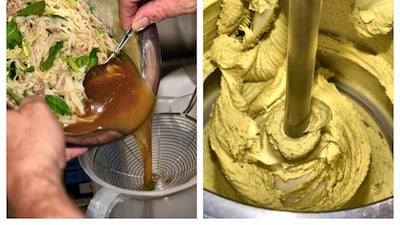Leaning over a counter in his spotless kitchen in Ho Chi Minh City, Ralf Ehresmann, 63, squints through his glasses as he calculates a careful measurement. "It has to be just right or it will taste horrible," he tells me as he pours pho noodle soup through a strainer and into a jug.
This hot, salty broth is the national dish of Vietnam. Pho is sold everywhere from street corners to five-star hotels, and is consumed for breakfast, lunch or dinner.
It is a bit risky, then, for a half-Italian, half-German resident to start experimenting with such a beloved dish. But Ehresmann likes taking risks – that is exactly how he ended up in Asia converting a noodle soup into gelato, a style of iced confection only introduced to Vietnam in recent years.
Ice cream is pandemic-proof
The owner of Ralf’s Artisan Gelato, Ehresmann left behind a corporate career in Europe to earn fame in the populous Vietnamese city by turning local foods, such as pho, nuoc mam fish sauce and black sticky rice, into gelato flavours.
Ehresmann’s curious innovations have been a blessing for him; they’ve helped his business survive the coronavirus pandemic.
Since opening in August 2016, Ralf's has built a loyal Vietnamese clientele. Compared with foreign customers, who prefer Ralf's sweet flavours such as coconut and strawberry, many locals who visit his shop adore his savoury creations, which come infused with a variety of meaty and fishy tastes.
This has meant that, despite international tourists having been absent from Vietnam for nearly a year now, Ralf’s has been able to maintain its key customer base.
In terms of containing the coronavirus, Vietnam has been one of the world's most successful nations. Despite its huge population of almost 100 million people, the country has been less affected by Covid-19, with 6,908 total cases and fewer than 50 deaths, according to data from the John Hopkins University.
This has meant businesses such as Ralf's have been able to operate as usual amid the pandemic, free of the movement restrictions that have been common elsewhere in the world.
"It may sound strange, but the pandemic – which Vietnam has excellently under control – has not noticeably damaged our business so far," Ehresmann says.
“It is almost the opposite [because] I suppose it’s easier to afford the small luxury of a scoop of ice cream than an extended meal in a restaurant.”
Flavour fest at Ralf’s Artisan Gelato
It was before the pandemic that I met Ehresmann in Ho Chi Minh City and learnt how he went from being a public relations executive in Frankfurt to a gelato trailblazer in Vietnam. Since then, Ralf's has moved into a new building in the riverside community of Thao Dien.
Ehresmann creates so many flavours of gelato and sorbet – more than 70 at last count – that they aren't all listed on the menu at Ralf's. His classic gelato varieties include stracciatella, pistachio, vanilla, coffee, tiramisu, chocolate, banana, hazelnut and caramel.
The sorbets, meanwhile, boast a huge variety of fruit infusions, including mango, guava, blackcurrant, redcurrant, passion fruit, kiwi, green apple, raspberry, sour cherry, peach and lemon. Those flavours are complemented by sorbets based on Asian fruits such as soursop, jackfruit, dragon fruit and durian.
In most shops, durian would be the strangest flavour on the menu. With its pungent odour, custard-like texture and the most acquired of tastes, the fruit is a polarising delicacy in Asia. It is banned from many hotels, owing to the stench it creates, but it is so popular it regularly sells for more than 440,000 Vietnamese dong ($19) per kilogram across the continent.
Yet the durian sorbet barely stands out on Ralf's menu, thanks to the presence of many other truly odd flavours. There is a gelato flavoured by tonka bean, a rare black legume from Central America, and tomato with chilli and chive. Curiouser still is the kem than, a gelato flavour that has "activated carbon from coconut shells for teeth whitening".
Above all of these flavours, though, the one most visitors to Ralf’s enquire about is the one that tastes like pho.
Pho ice cream
I was so intrigued by how Ehresmann managed to transform a favourite noodle soup into a flavour of gelato that I asked him to whip it up right in front of me.
“I make everything from scratch,” he told me proudly as we stood in his kitchen. “Most gelato shops use pre-mixed ingredients and artificial colours and additives, but that is the lazy way. The traditional way is to use only fresh ingredients, plus the sugar, water, milk or cream.”
As he was explaining this to me, one of his staff darted down the street to a favourite local pho restaurant and returned with a steaming hot beef version.
Ehresmann separated the soup from the noodles, meat and bean sprouts by pouring it through a sieve. He then measured the right amount of sugar and water, mixed that together with the soup and poured it into a vertical ice cream machine to freeze the mixture.
That was it. It seemed simple, really. The trick was in calculating the ingredient proportions exactly.
Passage to Vietnam
It helps, no doubt, that Ehresmann was born and raised in a country world-famous for its precision. Germans are known for being sticklers. Fuse that with the flair and inventiveness of the Italians, and you have a potent blend evident in the work of Ehresmann, who has an Italian mother and a German father.
From the time he was a child, he adored gelato. In 2010, he saw an opportunity to take over a gelato shop in the city of Munich.
Disillusioned with the corporate world and also going through a divorce, he decided to take a risk and switch careers. While running the shop in Munich, Ehresmann attended culinary institutes in Germany and Italy that specialised in training students to make artisanal gelato. Soon after, he met a “wonderful woman online”. She lived in Ho Chi Minh City.
After a few "very positive visits" to Vietnam, he took his next gamble and moved his business to Asia. Nearly five years later, Ehresmann is ensconced in his adopted nation. He spends his days dreaming up quirky new gelato flavours and says nothing makes him happier.
Ad Astra
Director: James Gray
Stars: Brad Pitt, Tommy Lee Jones
Five out of five stars
Breast cancer in men: the facts
1) Breast cancer is men is rare but can develop rapidly. It usually occurs in those over the ages of 60, but can occasionally affect younger men.
2) Symptoms can include a lump, discharge, swollen glands or a rash.
3) People with a history of cancer in the family can be more susceptible.
4) Treatments include surgery and chemotherapy but early diagnosis is the key.
5) Anyone concerned is urged to contact their doctor
PROFILE OF HALAN
Started: November 2017
Founders: Mounir Nakhla, Ahmed Mohsen and Mohamed Aboulnaga
Based: Cairo, Egypt
Sector: transport and logistics
Size: 150 employees
Investment: approximately $8 million
Investors include: Singapore’s Battery Road Digital Holdings, Egypt’s Algebra Ventures, Uber co-founder and former CTO Oscar Salazar
BRAZIL%20SQUAD
%3Cp%3EGoalkeepers%3A%20Alisson%2C%20Ederson%2C%20Weverton%3Cbr%3E%3Cbr%3EDefenders%3A%20Dani%20Alves%2C%20Marquinhos%2C%20Thiago%20Silva%2C%20Eder%20Militao%20%2C%20Danilo%2C%20Alex%20Sandro%2C%20Alex%20Telles%2C%20Bremer.%3Cbr%3E%3Cbr%3EMidfielders%3A%20Casemiro%2C%20Fred%2C%20Fabinho%2C%20Bruno%20Guimaraes%2C%20Lucas%20Paqueta%2C%20Everton%20Ribeiro.%3Cbr%3E%3Cbr%3EForwards%3A%20Neymar%2C%20Vinicius%20Junior%2C%20Richarlison%2C%20Raphinha%2C%20Antony%2C%20Gabriel%20Jesus%2C%20Gabriel%20Martinelli%2C%20Pedro%2C%20Rodrygo%3C%2Fp%3E%0A
Cinco in numbers
Dh3.7 million
The estimated cost of Victoria Swarovski’s gem-encrusted Michael Cinco wedding gown
46
The number, in kilograms, that Swarovski’s wedding gown weighed.
1,000
The hours it took to create Cinco’s vermillion petal gown, as seen in his atelier [note, is the one he’s playing with in the corner of a room]
50
How many looks Cinco has created in a new collection to celebrate Ballet Philippines’ 50th birthday
3,000
The hours needed to create the butterfly gown worn by Aishwarya Rai to the 2018 Cannes Film Festival.
1.1 million
The number of followers that Michael Cinco’s Instagram account has garnered.
NATIONAL%20SELECTIONS
%3Cp%3E6.00pm%3A%20Heros%20de%20Lagarde%3Cbr%3E6.35pm%3A%20City%20Walk%3Cbr%3E7.10pm%3A%20Mimi%20Kakushi%3Cbr%3E7.45pm%3A%20New%20Kingdom%3Cbr%3E8.20pm%3A%20Siskany%3Cbr%3E8.55pm%3A%20Nations%20Pride%3Cbr%3E9.30pm%3A%20Ever%20Given%3C%2Fp%3E%0A
Martin Sabbagh profile
Job: CEO JCDecaux Middle East
In the role: Since January 2015
Lives: In the UAE
Background: M&A, investment banking
Studied: Corporate finance
Attacks on Egypt’s long rooted Copts
Egypt’s Copts belong to one of the world’s oldest Christian communities, with Mark the Evangelist credited with founding their church around 300 AD. Orthodox Christians account for the overwhelming majority of Christians in Egypt, with the rest mainly made up of Greek Orthodox, Catholics and Anglicans.
The community accounts for some 10 per cent of Egypt’s 100 million people, with the largest concentrations of Christians found in Cairo, Alexandria and the provinces of Minya and Assiut south of Cairo.
Egypt’s Christians have had a somewhat turbulent history in the Muslim majority Arab nation, with the community occasionally suffering outright persecution but generally living in peace with their Muslim compatriots. But radical Muslims who have first emerged in the 1970s have whipped up anti-Christian sentiments, something that has, in turn, led to an upsurge in attacks against their places of worship, church-linked facilities as well as their businesses and homes.
More recently, ISIS has vowed to go after the Christians, claiming responsibility for a series of attacks against churches packed with worshippers starting December 2016.
The discrimination many Christians complain about and the shift towards religious conservatism by many Egyptian Muslims over the last 50 years have forced hundreds of thousands of Christians to migrate, starting new lives in growing communities in places as far afield as Australia, Canada and the United States.
Here is a look at major attacks against Egypt's Coptic Christians in recent years:
November 2: Masked gunmen riding pickup trucks opened fire on three buses carrying pilgrims to the remote desert monastery of St. Samuel the Confessor south of Cairo, killing 7 and wounding about 20. IS claimed responsibility for the attack.
May 26, 2017: Masked militants riding in three all-terrain cars open fire on a bus carrying pilgrims on their way to the Monastery of St. Samuel the Confessor, killing 29 and wounding 22. ISIS claimed responsibility for the attack.
April 2017: Twin attacks by suicide bombers hit churches in the coastal city of Alexandria and the Nile Delta city of Tanta. At least 43 people are killed and scores of worshippers injured in the Palm Sunday attack, which narrowly missed a ceremony presided over by Pope Tawadros II, spiritual leader of Egypt Orthodox Copts, in Alexandria's St. Mark's Cathedral. ISIS claimed responsibility for the attacks.
February 2017: Hundreds of Egyptian Christians flee their homes in the northern part of the Sinai Peninsula, fearing attacks by ISIS. The group's North Sinai affiliate had killed at least seven Coptic Christians in the restive peninsula in less than a month.
December 2016: A bombing at a chapel adjacent to Egypt's main Coptic Christian cathedral in Cairo kills 30 people and wounds dozens during Sunday Mass in one of the deadliest attacks carried out against the religious minority in recent memory. ISIS claimed responsibility.
July 2016: Pope Tawadros II says that since 2013 there were 37 sectarian attacks on Christians in Egypt, nearly one incident a month. A Muslim mob stabs to death a 27-year-old Coptic Christian man, Fam Khalaf, in the central city of Minya over a personal feud.
May 2016: A Muslim mob ransacks and torches seven Christian homes in Minya after rumours spread that a Christian man had an affair with a Muslim woman. The elderly mother of the Christian man was stripped naked and dragged through a street by the mob.
New Year's Eve 2011: A bomb explodes in a Coptic Christian church in Alexandria as worshippers leave after a midnight mass, killing more than 20 people.
More from Neighbourhood Watch:
Brief scores:
Toss: India, opted to field
Australia 158-4 (17 ov)
Maxwell 46, Lynn 37; Kuldeep 2-24
India 169-7 (17 ov)
Dhawan 76, Karthik 30; Zampa 2-22
Result: Australia won by 4 runs by D/L method
What can victims do?
Always use only regulated platforms
Stop all transactions and communication on suspicion
Save all evidence (screenshots, chat logs, transaction IDs)
Report to local authorities
Warn others to prevent further harm
Courtesy: Crystal Intelligence
COMPANY PROFILE
Name: Kumulus Water
Started: 2021
Founders: Iheb Triki and Mohamed Ali Abid
Based: Tunisia
Sector: Water technology
Number of staff: 22
Investment raised: $4 million
UK’s AI plan
- AI ambassadors such as MIT economist Simon Johnson, Monzo cofounder Tom Blomfield and Google DeepMind’s Raia Hadsell
- £10bn AI growth zone in South Wales to create 5,000 jobs
- £100m of government support for startups building AI hardware products
- £250m to train new AI models
Jeff Buckley: From Hallelujah To The Last Goodbye
By Dave Lory with Jim Irvin
Women’s World T20, Asia Qualifier
UAE results
Beat China by 16 runs
Lost to Thailand by 10 wickets
Beat Nepal by five runs
Beat Hong Kong by eight wickets
Beat Malaysia by 34 runs
Standings (P, W, l, NR, points)
1. Thailand 5 4 0 1 9
2. UAE 5 4 1 0 8
3. Nepal 5 2 1 2 6
4. Hong Kong 5 2 2 1 5
5. Malaysia 5 1 4 0 2
6. China 5 0 5 0 0
Final
Thailand v UAE, Monday, 7am
SPIDER-MAN%3A%20ACROSS%20THE%20SPIDER-VERSE
%3Cp%3EDirectors%3A%20Joaquim%20Dos%20Santos%2C%20Kemp%20Powers%2C%20Justin%20K.%20Thompson%3Cbr%3EStars%3A%20Shameik%20Moore%2C%20Hailee%20Steinfeld%2C%20Oscar%20Isaac%3Cbr%3ERating%3A%204%2F5%3C%2Fp%3E%0A
The bio:
Favourite film:
Declan: It was The Commitments but now it’s Bohemian Rhapsody.
Heidi: The Long Kiss Goodnight.
Favourite holiday destination:
Declan: Las Vegas but I also love getting home to Ireland and seeing everyone back home.
Heidi: Australia but my dream destination would be to go to Cuba.
Favourite pastime:
Declan: I love brunching and socializing. Just basically having the craic.
Heidi: Paddleboarding and swimming.
Personal motto:
Declan: Take chances.
Heidi: Live, love, laugh and have no regrets.
more from Janine di Giovanni
Four%20scenarios%20for%20Ukraine%20war
%3Cp%3E1.%20Protracted%20but%20less%20intense%20war%20(60%25%20likelihood)%3C%2Fp%3E%0A%3Cp%3E2.%20Negotiated%20end%20to%20the%20conflict%20(30%25)%3C%2Fp%3E%0A%3Cp%3E3.%20Russia%20seizes%20more%20territory%20(20%25)%3C%2Fp%3E%0A%3Cp%3E4.%20Ukraine%20pushes%20Russia%20back%20(10%25)%3C%2Fp%3E%0A%3Cp%3E%3Cem%3EForecast%20by%20Economist%20Intelligence%20Unit%3C%2Fem%3E%3C%2Fp%3E%0A
2025 Fifa Club World Cup groups
Group A: Palmeiras, Porto, Al Ahly, Inter Miami.
Group B: Paris Saint-Germain, Atletico Madrid, Botafogo, Seattle.
Group C: Bayern Munich, Auckland City, Boca Juniors, Benfica.
Group D: Flamengo, ES Tunis, Chelsea, Leon.
Group E: River Plate, Urawa, Monterrey, Inter Milan.
Group F: Fluminense, Borussia Dortmund, Ulsan, Mamelodi Sundowns.
Group G: Manchester City, Wydad, Al Ain, Juventus.
Group H: Real Madrid, Al Hilal, Pachuca, Salzburg.
